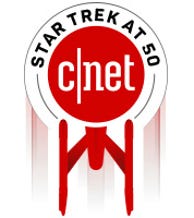By Ian Sherr
Got a Star Trek story?
Maybe, like me, you dressed in starship captain uniforms for Halloween and snuck into the family room past your bedtime to watch reruns, no matter how tired you’d be the next day at school.
Or maybe you never watched “Star Trek,” but you still know the difference between Klingons and Romulans. At the very least, you probably know how to separate your fingers into the iconic Vulcan salute and offer up a “Live long and prosper.”
With the Star Trek franchise turning 50 on September 8, I asked a dozen cast members from six of Star Trek’s TV shows and movies, including Zoe Saldana, Gates McFadden and Jeri Ryan, to share their stories for CNET’s Star Trek at 50 anniversary series.
 When Star Trek was born in 1966, it was the heart of the Cold War and the scars of World War II, which ended just two decades before, were still fresh. That’s why many viewers were surprised to see a Japanese helmsman working alongside a Russian ensign on the show.
When Star Trek was born in 1966, it was the heart of the Cold War and the scars of World War II, which ended just two decades before, were still fresh. That’s why many viewers were surprised to see a Japanese helmsman working alongside a Russian ensign on the show.
They were joined by a black woman who served as the communications officer, a Scottish engineer working tirelessly to keep the ship running and an emotionless alien science officer with pointy ears. The divisions that defined the world at that time didn’t seem to matter to Star Trek creator Gene Roddenberry.
Michael Dorn, who starred in two Star Trek shows and five movies and is best known for playing the Klingon Worf, remembers how the original TV show stood out from the westerns and spy thrillers typical of ’60s TV.
“When this came about it was like, ‘Oh my God,'” Dorn said. “It was groundbreaking and different.”
Star Trek went on to become a cultural touchstone that spawned six other TV shows, including a new series called “Star Trek: Discovery,” coming from CNET parent company CBS in January. There have also been 13 movies, dozens of books, and more comics, video games and toys than you can imagine.
This fantastical world dreamed up by Roddenberry — a former combat and commercial pilot, plane crash investigator and Los Angeles police officer — inspired generations to pursue careers in science, the military, medicine and the arts.
And the world Roddenberry envisioned spurred products that helped bring the show’s fantasies closer to reality. The communicator that Capt. James T. Kirk used to hail his crew on the starship Enterprise inspired the clamshell design of flip phones. Virtual-reality entrepreneurs say they’re trying to re-create the Holodeck. There’s currently a competition to create a real-life medical scanner, known on the show as a “tricorder.”
Star Trek’s recognition extends to the Smithsonian, where the model of the Enterprise used in the first show is on display, next to the Apollo 11 capsule used by Neil Armstrong and his crew for their journey to the moon and the Spirit of St. Louis, the airplane Charles Lindbergh piloted on the first solo flight across the Atlantic.
Even a space shuttle — the real type, used by NASA — was named after the Enterprise. So was one of the private space planes owned by Virgin CEO Richard Branson. The other was initially named after the titular ship in “Star Trek: Voyager.” (It was later named Unity.)
Sure, Star Trek has been a financial blockbuster — the movies alone have pulled in more than $2 billion by one estimate. But Roddenberry’s dreamworld helped show that advanced technology and space travel were not only possible but normal.
